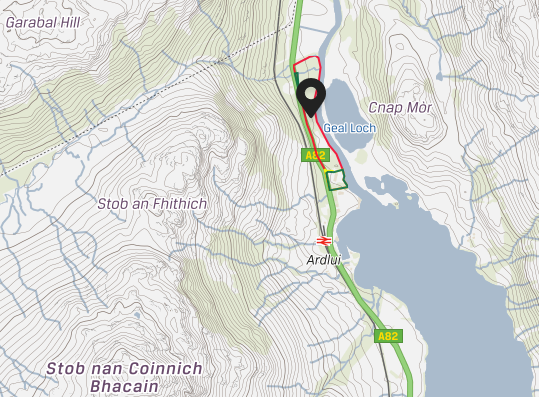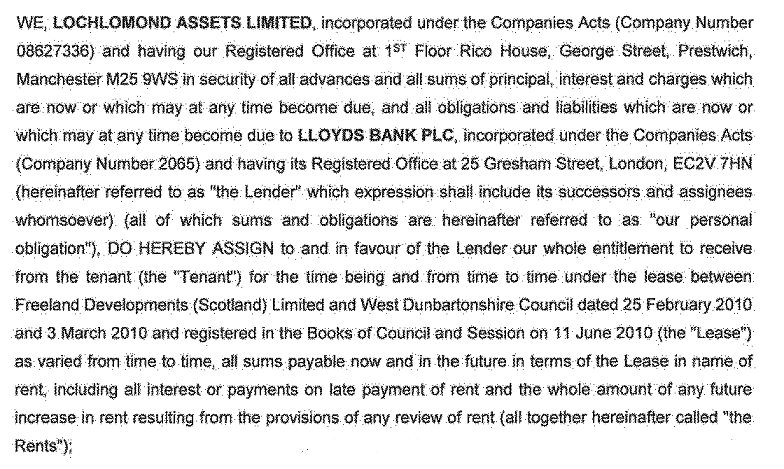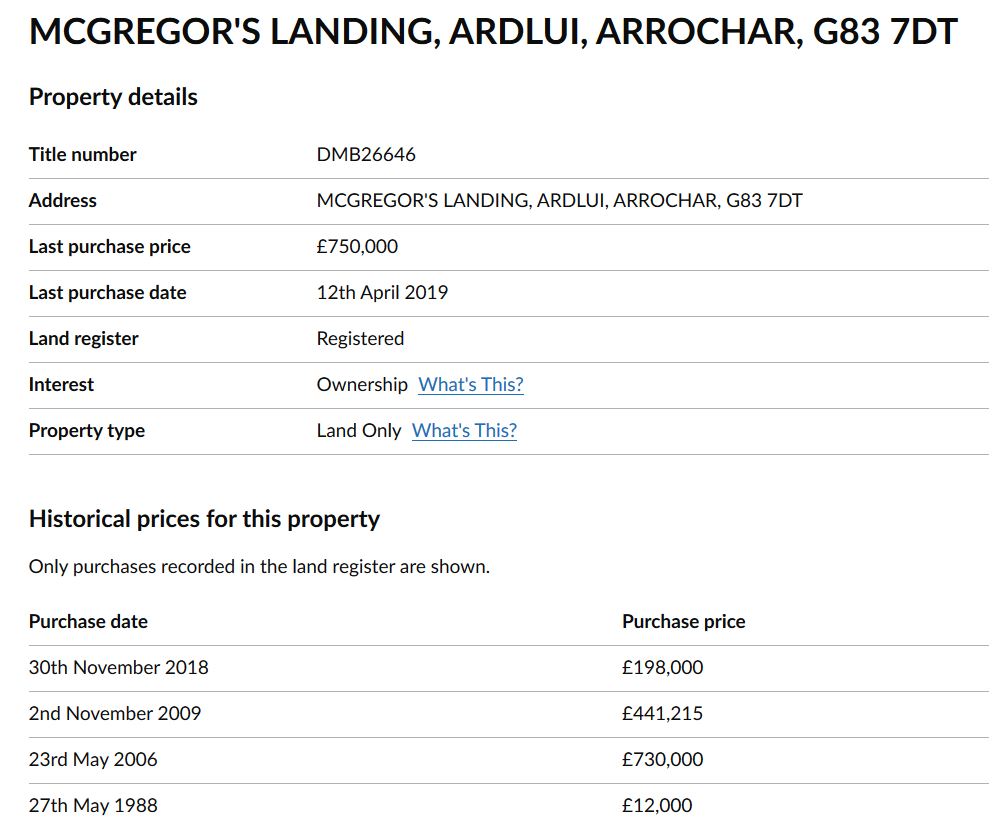A week ago, Land Use Consultants withdrew their request to the Loch Lomond and Trossachs National Park Authority for a scoping opinion about a possible chalet development on land between the River Falloch and the A82 north of Ardlui (see here) after a large area of ancient woodland had been unlawfully felled.
Back in 1992 the land occupied by the abandoned Ardlui Outdoor Centre, extending north along the banks of the River Falloch, was undeveloped and in single ownership:

The landholding was then effectively split in two, with the Planning Authorities at the time agreeing the green square should become a development site while the red strip of ancient woodland was left to nature. What has happened to both since raises serious questions about how land in our National Parks is currently owned and managed.
The sad history of Ardlui Outdoor Centre

Initially a Visitor Centre was constructed on the development site but then, in 2010, it was converted into an Outdoor Centre by West Dunbartonshire Council. On 22nd February 2010 WDC signed a lease for the land and buildings which committed them to pay £65k a year for 25 years.
Three years later, on 14th October 2013, the owners of the land and buildings, Freeland Developments, sold the land to Loch Lomond Assets Ltd for £810k.
Then, in 2015, five years after opening, WDC closed the Outdoor Centre despite widespread opposition (see here). It has remained empty ever since.
On 28th December 2018 information at Companies House shows Lloyds Bank PLC registered a charge over the property:

The reason for the charge is not explained but it gives Lloyd’s bank the right to receive all rents.
Recently, Councillor Jim Bollan of the Community Party, who had campaigned vigorously against the closure, obtained confirmation from WDC officials that the Council are still paying the rent. For five years WDC have been paying £65k a year for nothing. It would have been far cheaper if they had bought the land and buildings for £810k in 2013 than pay over £1,625,000 in rent over 25 years.
The challenge for councils is that central government in Scotland, while trumpeting community ownership, makes it almost impossible for public authorities to acquire land. Moreover, it puts continuous pressure on public authorities to sell off assets. Examples in the Loch Lomond and Trossachs National Park include Scottish Enterprise’s attempt to sell its land at Balloch to Flamingo Land (see here) and Forest and Land Scotland’s marketing of Ewich Forest at Crianlarich (see here). The system is designed in the private not the public interest.
The financial disaster at Ardlui is just one example of the collapse of outdoor education provision in Scotland. Last year Glasgow City Council threatened to close Blairvadach Outdoor Centre (see here). The Covid crisis now means that almost every remaining outdoor centre in Scotland faces financial collapse (you can sign a petition against closure here). This is at a time when outdoor education is needed more than ever before. Whether it’s the number of mountain rescue call-outs, the amount of litter being left in the countryside or people trying to burn live branches from trees, part of the explanation lies in the cuts to outdoor education that have taken place over the last ten years. We need to teach both urban and rural people about the countryside and there is no better way to do this than residential outdoor education.
Any Covid recovery plan for the National Park should include investment to get Ardlui and the other outdoor centres operational again and purchase of the land and buildings should form part of this.
Land speculation on the banks of the River Falloch
The scoping opinion for a chalet development was submitted on behalf of SSH Trading Ltd, a company based in Manchester, which was used to buy this narrow and boggy strip of land 18 months ago:

The land has now changed hands four times in the last 14 years but why the dramatic changes in price? And, more specifically, why the sudden jump from £198k at the end of November 2018 to £750k four and a half months later? Someone made a huge profit on the last transaction.
When the request for the scoping opinion was withdrawn last week, the Loch Lomond and Trossachs National Park Authority removed a number of supporting documents from the planning portal. In my view this is totally wrong but I have learned to keep copies. The Screening Report from Land Use Consultants (too big at 4MB to upload here) contained a section headed “Public Consultation” which revealed that:
“Discussions between the Applicant and the LLTNPA were primarily undertaken in December 2018 and a ‘Proposal of Application Notice’ (PAN) will be submitted.”
If the date is right, the main discussions between the LLTNPA as planning authority and SSH trading took place before they had bought the land. The implication is that SSH trading came away from those discussions believing they could secure planning approval to develop the land, even though the LLTNPA has a strong policy presumption against any development on ancient woodland sites, and it was therefore worth paying £750k for it. How could that have happened?
The dates on the Registers of Scotland also tell us that the felling of ancient woodland on the site took place after SSH trading had bought the land and it appears therefore that they are ultimately responsible for the destruction. While Forestry Scotland are responsible for investigating and taking enforcement action against illegal tree felling, there are wider matters associated with the planning application that it would be in the public interest to investigate.
The absence of controls over who can own land in our National Parks
What has happened on these two relatively small parcels of land at Ardlui raise some fundamental questions about land-ownership in our National Parks. Why are we allowing land in our National Parks to be traded for private gain rather than the public interest? Why aren’t prospective owners of significant pieces of land in our National Park – excluding domestic properties – vetted before any sale can be agreed? Do we not need to strengthen our land reform legislation so that communities and public authorities have first call on any land sold in our National Parks, whether or not an interest has been registered previously?
To illustrate the extent of the issue, in the last 18 months, the two large landholdings that surround Ardlui have both exchanged hands without any scrutiny. Most of the land on the north west side of Loch Lomond, from the shore to the summit of Ben Vorlich, belongs to Stuckendroin Farm. This was bought in December 2018 by OC DANMARK HOLDING A/S for £1,567,000. Then Garabal (see here), just to the north, was sold for £2,700,000 on 18th October 2019 to Simon and Gemma Hartwright from Abington. I have not, from an internet search, been able to find out much about either purchaser although the latter are clearly a very wealthy couple.
Taken all together a huge chunk of the National Park has changed hands in the last two years without any scrutiny. . The way all these owners intend to manage their land has significant implications for the National Park but we don’t at present even ask them what they intend to do before they buy the land, let alone whether this is in the interests of conservation, outdoor recreation or local communities.
We need a public debate about how we can bring most of the land in our National Parks into public, charitable or community ownership in the medium term. But for the present, at the very least, we need a system where prospective private owners are required to sign up to land management plans that put our National Park’s statutory objectives first. Until that happens the scandalous misuse of land will continue.

The priority for public ownership of land should be all the non- domestic land in the Camping Management Zones. Local communities should use the forthcoming powers contained within part 5 of the Land Reform(Scotland) Act 2016 to purchase most of the land in the CMZs, using the compulsory powers available within the Act if necessary. That would ensure that new camping facilities can be built without hindrance from private estates or exploitation for commercial purposes. And the land surrounding these new camping facilities can also be better managed if under community control rather than misuse for private profit.
Simon and Gemma Hartwright own Harty Homes Ltd (incorporated 2019), and Grove Farms Turf Ltd (incorporated 2017). HH was set up with an initial £500k capital injection and hasn’t been going long enough to do a company return. GFT is a micro-company supplying turf and topsoil. It trades under the name “Turf Direct”.
OC DANMARK HOLDING A/S appears to specialise in forestry and is run by Otto Johannes Christensen. He also chairs the Inga and Peter Christensen’s Family Fund, which has a large stake. He appears to be a corporate lawyer – presumably looking after the family money.
Surely WDC’s continued payout for a property that it cannot or doesn’t want to use is not in the public interest and should therefore be reported to the Local Government Minister and to Audit Scotland, for investigation?
It seems the rancid smell coming from the park is not discarded rubbish it is the stench of corruption
During the noughties some of the locals moored an old boat in the middle of the R Leven, upstream of the railway bridge between Dumbarton Central and Dalreoch stations. It had a “sail” up with the words “The Big Bung” written on it. That’s code for WDC’s financial transactions.
Also check out Hillhead of Catter and The Thirds farms , both changed hands in the spring .One wealthy buyer , not local , check price inflation there . It ticks the right boxes , it is to be rewilded. No doubt a large input of tax payers money to assist large scale tree planting etc….. Small farmers are now the endangered species. – they are the custodians of the land and the wildlife , they know where the ospreys , the hen harriers , the marsh harriers are , to name but a few . – yet are priced out of the market by wealthy incomers , by market skewed by huge sums for any one selling forestry , by trebling of cost of summer grazing due to anaerobic digestor managers paying treble the normal price – – it is impossible for a sheep farmer to break even at present cost per acre The green levy on energy bills , tax payers money , is supporting these initiatives . The Government is ultimately to blame .- short sighted and incapable of predicting consequences . .
Do you have any idea who has bought these farms?
I used to help with hay for the Frasers when they owned Third.
I walked that way for the first time in years, and it was such a shame to see the buildings in a parlous state, culverts overflowing and the gateways damaged.
Is the out door centre ( we thought it might have been a hotel ) for sale now . Iv stopped a couple times including yesterday,3/2/24 and it is something I could do something with !???
I am lucky to have been brought up here on Garabal farm from 1958 -1972 and have great memories too.